An overnight trip into the wilds of the west coast to Welcome Flat Hut along the Copland Track. A long walk along the Copland River with steaming natural hot pools and views of soaring snow-capped mountains waiting at the end as a reward.
Length: 18km one-way
Time taken: 7 hours one-way, overnight
Difficulty: moderate
Facilities: There is a long-drop toilet and fresh stream at the trailhead carpark. (Along with plenty of parking and normally hordes of sandflies – bring repellent!). There are also numerous streams for fresh water along the track.
Architect Hut is just over halfway to the hot pools. It has a long-drop toilet, two mattresses and a water tank. DOC have recently removed the fireplace. I wouldn’t recommend staying here unless you’re tenting.
Welcome Flat Hut sits next to the hot pools. DOC recently upgraded the hut. It sleeps 31 people in four seperate bunk rooms (+4 people in the private Sierra Room). There are even flushing(!) toilets, water, and a fire. You need to book online year-round (you can book here). There is a DOC warden year-round to check tickets. They won’t let you sleep on the floor if you haven’t booked a bed. There’s also a campsite and a bivvy rock next to the hut.
– Important: The Copland Track is drastically affected by the wild west coast weather. Flooding often causes it to close. Due to the numerous stream crossings, and proximity of the track to the river, it would be very dangerous to attempt to complete the Copland Track when heavy rain has or will be forecast (which occurs frequently on the west coast of New Zealand). Always check with the local DOC office first. –

Why Copland Track / Welcome Flat Hut?
Imagine: natural hot pools at the end of a hike into the wilderness, with views of soaring snow-capped mountains. Apart from the sandflies, what’s not to like?
During their honeymoon over 30 years ago, my parents climbed from Hooker Valley over the Copland Pass and down into the valley to the Welcome Flat hot pools (back when the pass was much more accessible). They’ve since regaled me with stories of soaking their weary muscles in the hot pools. And on another trip watching snow falling only to melt in the steam before it even touched the warm water. The Copland Track had been on my to-do list for a long time. But its remote location and west coast weather made timing very difficult.
But once I’d moved back down south from the North Island, we were somehow blessed with a beautiful weather window over a weekend. In winter. When I was free. Hallelujah! I rustled up my husband and two keen / gullible workmates, and we were off.

How to get to the Copland Track
The trailhead for the Copland Track is located off State Highway 6 on the west coast of the South Island, between Haast and Fox Glacier. The turn-off is about an hour and a half north of Haast, just over the long one-way bridge over Karangarua River. (Although navigating by one-way bridges on the west coast is a useless exercise since it’s their ancestral homeland). Or it’s half an hour south of Fox. The turn-off through a wooden gate to the carpark is well sign-posted.
Our group stayed the night at Haast. We were on the road the next morning before sunrise. Gorgeous light over the mountains and the coast rewarded us for the early start. The west coast is not just a different region, it honestly feels like a different country, wild and free.


The tramp – Day One to Welcome Flats Hut
On the drive north to the trailhead, I oscillated between spouting about how amazing the light was, and giving out near constant warnings about sandflies. (One of my workmates, Michael from Australia, had not yet had the dubious pleasure of making their acquaintance). But upon our arrival to the carpark, I was struck, not by swarms of the black insects, but by the absolute lack of sandflies. One of the benefits of getting up early in winter, even on the west coast! Being proven wrong was a pleasant surprise in this case. (But don’t worry, Michael got to experience them plenty on arriving back to the carpark. And then driving in “thongs” (Australian) / jandals (NZ) / flip flops (everywhere else). Sandflies have a thing about feet).
We got ourselves and our gear ready, then, with loosely laced boots and not even bothering to do up our packs’ waist-belts, we headed out on our adventure.
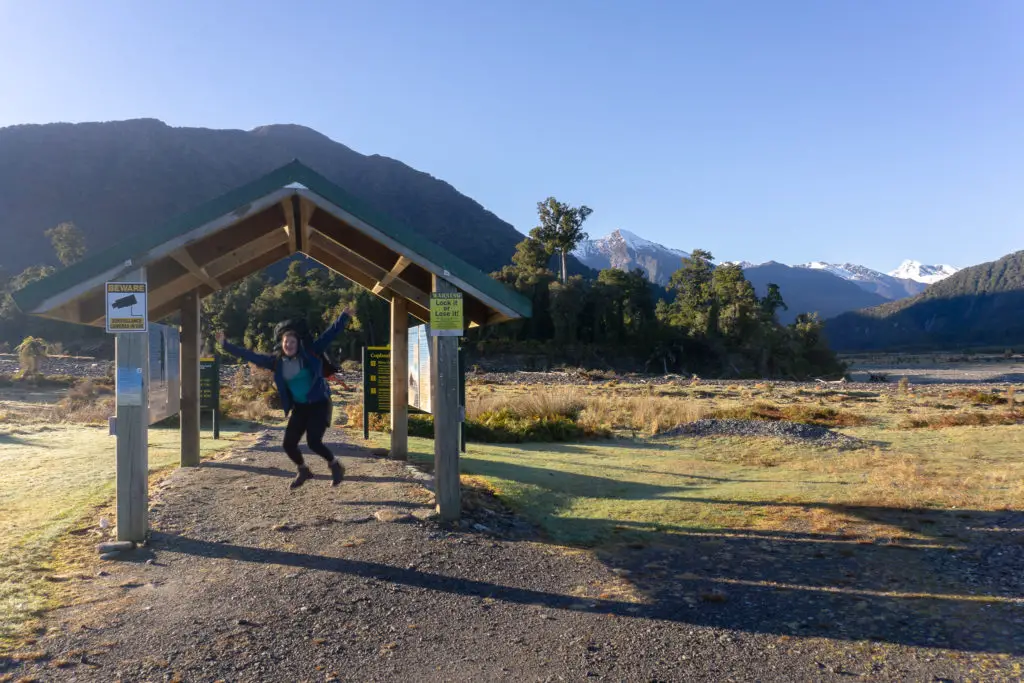
The reason we hadn’t bothered tightening our boots and packs was soon apparent. The crossing over Rough Creek was just a small stream for us due to there having been little rain. But it can quickly turn into a raging torrent if it has been raining. There is a “flood bridge” upstream that you can use in emergencies. But this would add another ~1.5 hrs to the walk. Plus if Rough Creek is in flood then it would be extremely inadvisable to continue with the rest of the Copland Track. All of the side streams and the Copland River would likely be running high too.
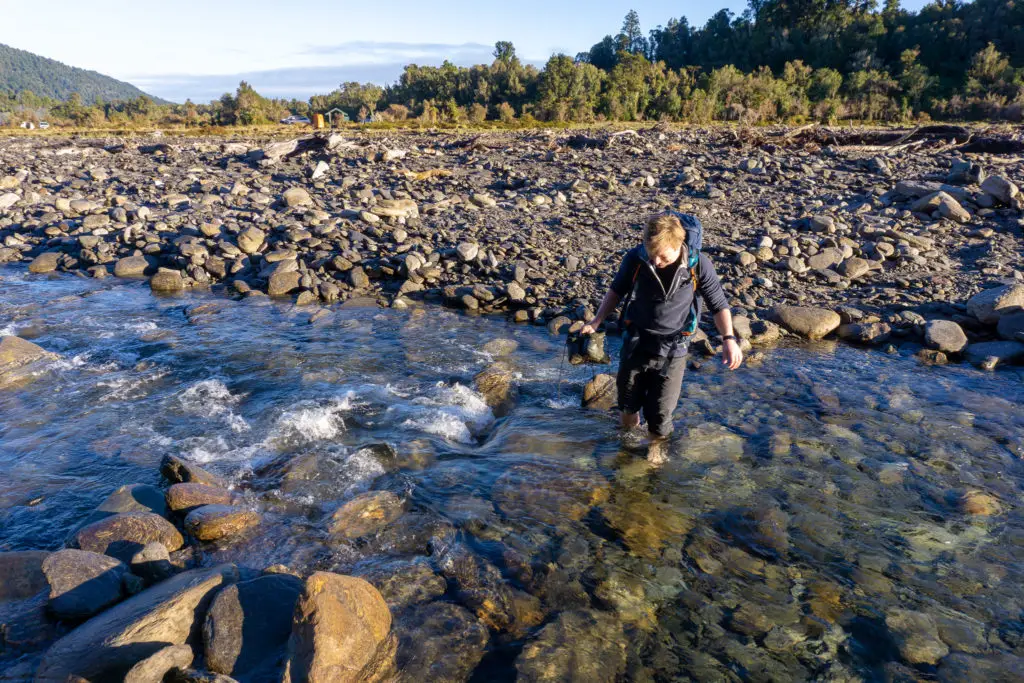
Rough Creek was toe-numbingly cold. But once our boots were back on and we were walking, our feet quickly warmed up again. Definitely worth having dry socks and boots for the start of the day!
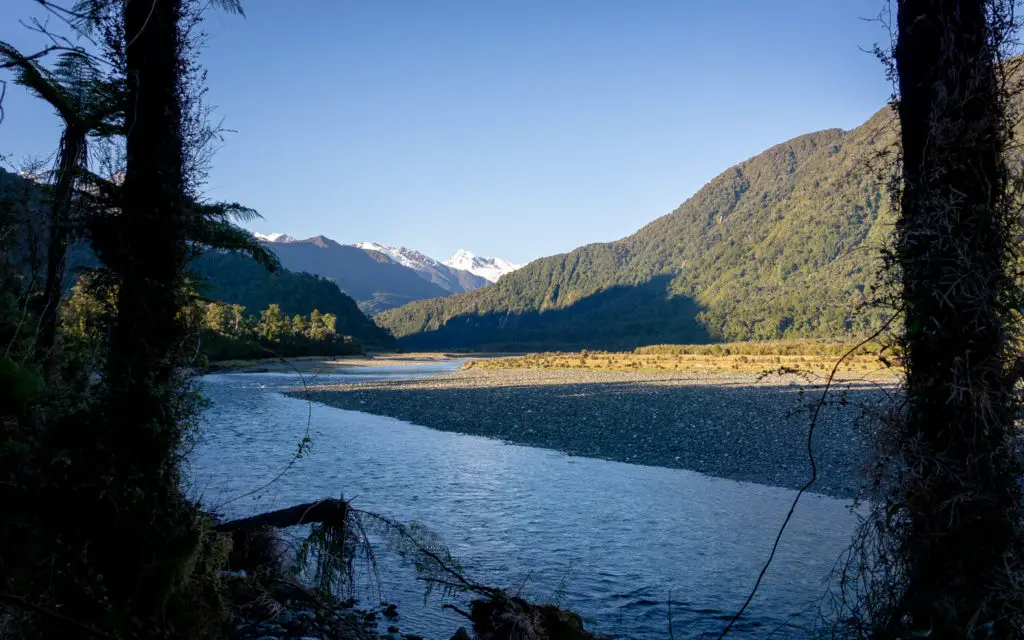
The first section of the Copland Track meanders through lush west coast bush next to the Karangarua River. There are tantalising views across the river flats to the mountains. This part of the track was particularly muddy in fine weather with a few small stream crossings. I can only imagine after rain it would be pretty horrendous. As it was, I was very thankful my gaiters kept the mud and leaf litter out of my boots. Michael asked Becky and I why we were wearing gaiters, since we didn’t have to protect our legs against snake bites. Australia, what are you even like?
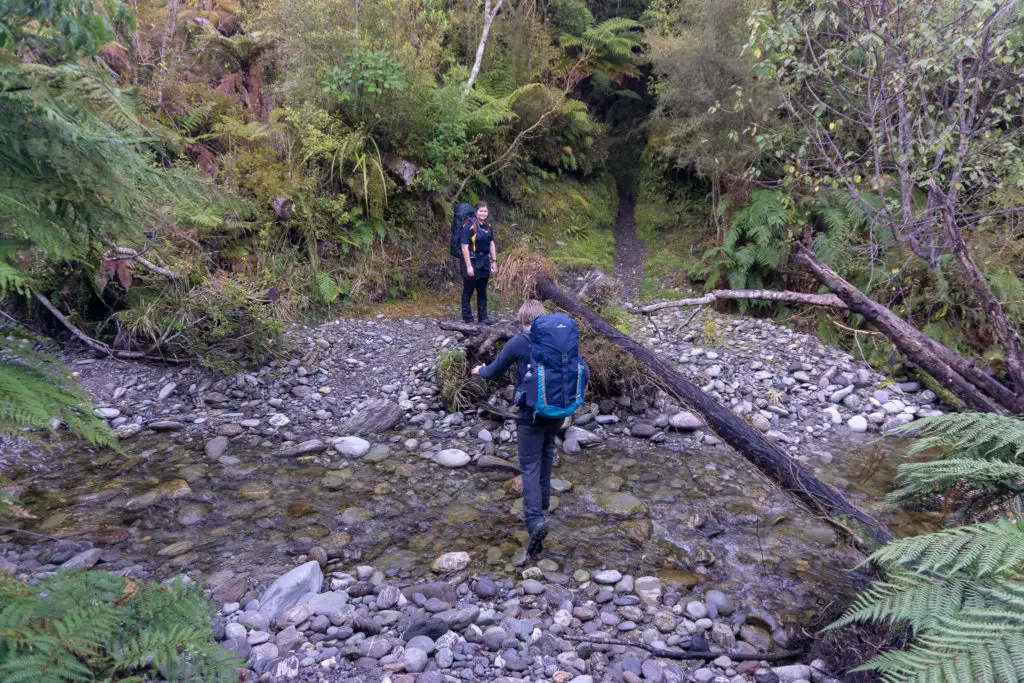
All of the stream crossings (other than Rough Creek) were relatively easy. Either a jump across or trust to stepping stones. We all managed to keep our boots dry with minimal effort. If they were in flood however some of the streams would be impassable.

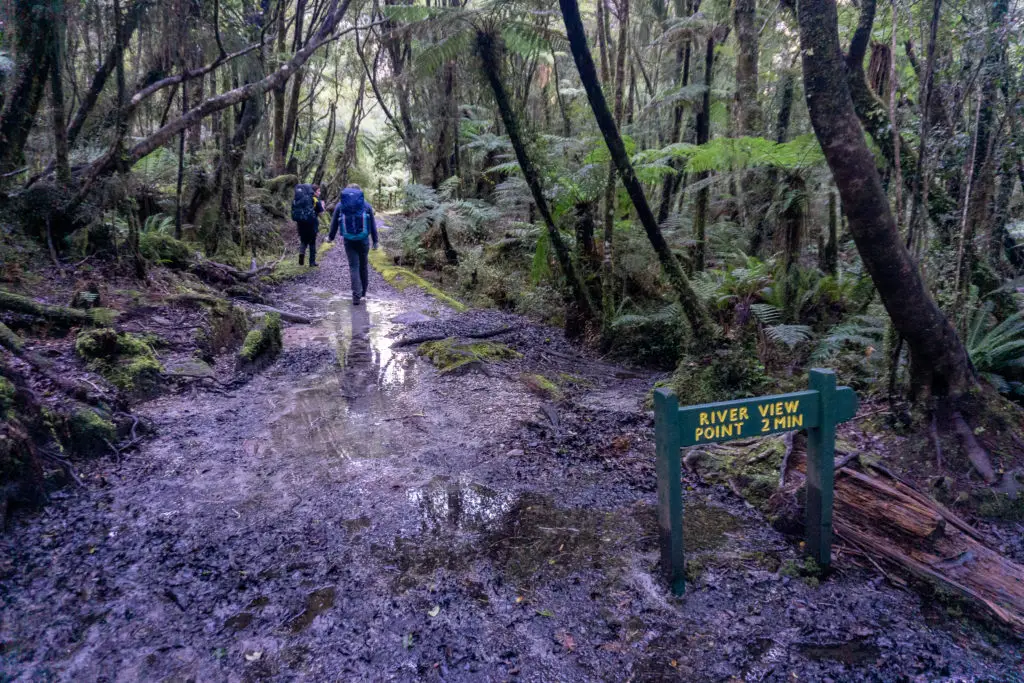
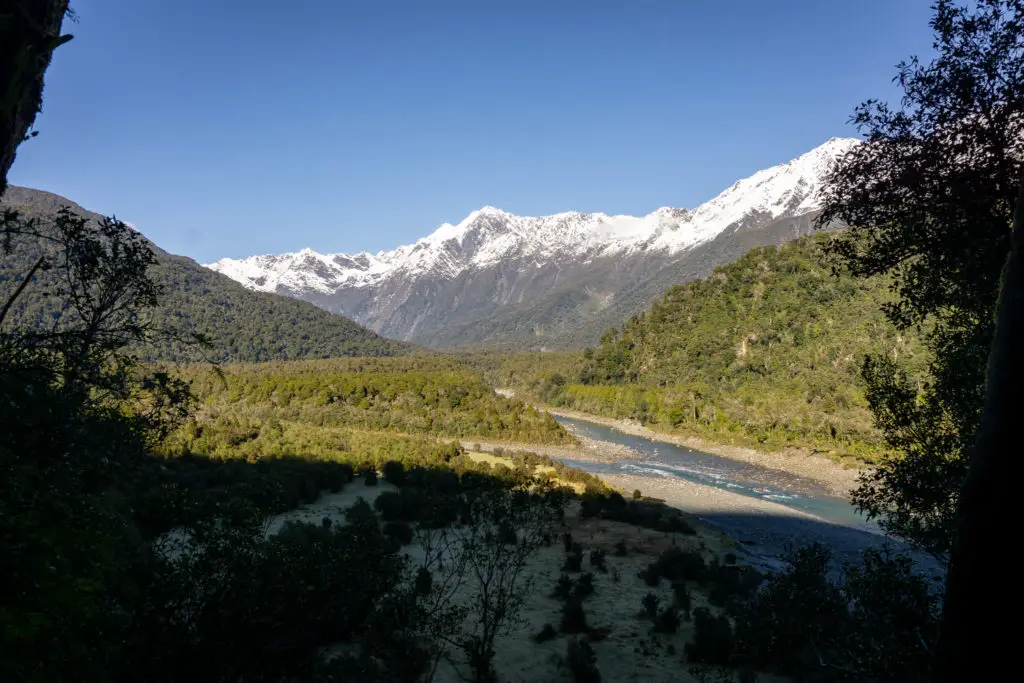
Although there had been a few vehicles in the carpark, we’d had the track all to ourselves. But after the river viewpoint we passed two separate couples returning from Welcome Flat Hut. All four of them were ridiculously beautiful. People who look like they’re ready to start posing for an active wear fashion shoot instead of having plodded through the wilderness for hours and hours. Clean clothes, shiny, flowing hair and beautiful faces that don’t need makeup. They were like a tramping version of the ridiculously photogenic marathon guy.
Becky and I looked at each other in comparison (red faces, frizzy hair and loose-fitting t-shirts) and laughed. Perhaps we were going to the hot springs of eternal youth and beauty? To top it all off one of the model men said they’d only been going for three hours (which would mean they’d likely do the the seven hour hike in FOUR hours). My mere mortal brain couldn’t compute.
After getting over my disbelief that gods walked amongst us, the view of the river was soon distracting me from negotiating the rocks and tree roots. Its green / blue water was incredibly clear and inviting, even on a winter’s day. Not too long after it had come into view, we were able to branch off the track down to its rocky banks for another quick break (still no sandflies!). The water was honestly so ridiculously green and crystal clear.
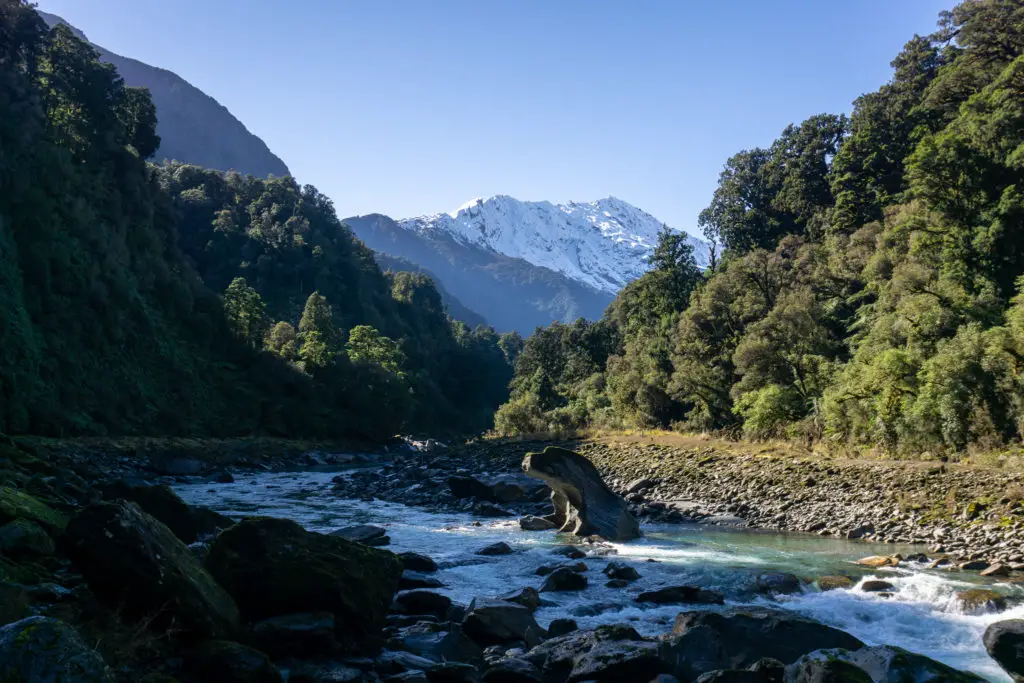
We’d actually stopped just downstream from one of the more unusual landmarks on the Copland Track – a rock in the river which looks like the head of an Irish setter. It had taken us about 2.5 hours to get to this point. From here until Architect Hut the track alternated between boulder hopping next to the river and bush walking, with a few bridges. (One of which was a dodgy-looking swing bridge whose steps didn’t even touch the ground).

There was a beautiful beach before Architect Hut where we had another break. Next to it was a landslide with a beautiful fern-covered cliff. We inched our way around and tried not to get dripped on from overhanging leaves far above.

It took us about four hours from the carpark to reach Architect Hut, but if you’re a speed walker / tramping god you could make it much faster. Architect Hut is a small two-bed hut that looks like it’s seen better days. It’s just over halfway to Welcome Flat Hut (and less than halfway on the way back – important to remember!). It’s known for its swarms of sandflies, however there were none bothering us, so we stopped here for lunch.
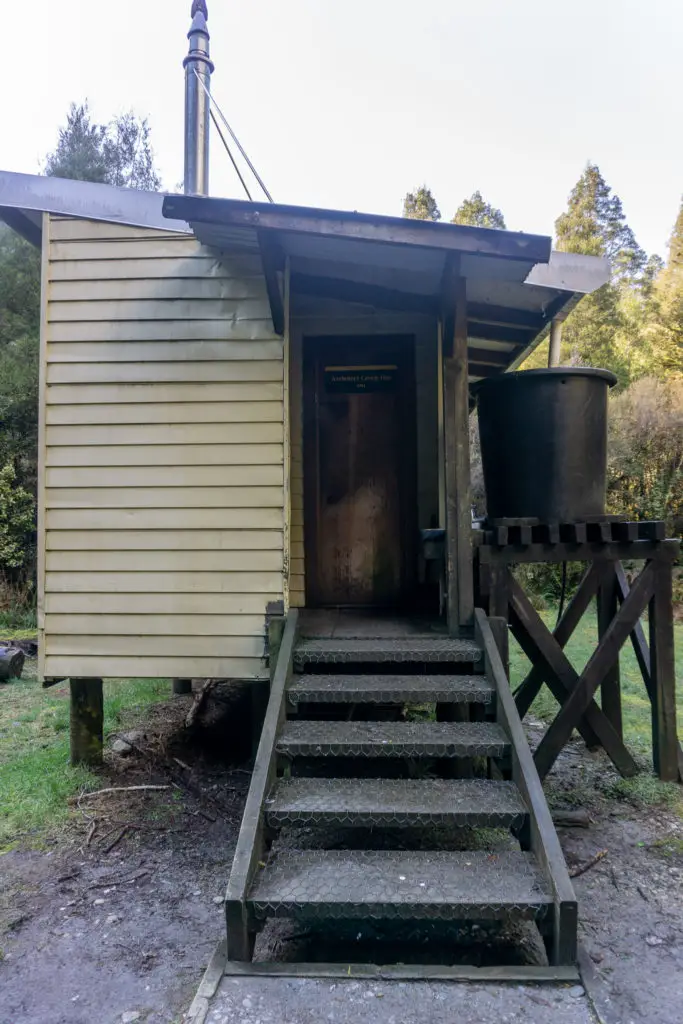
A small, but steep, section of downhill after Architect Hut and we had reached the swing bridge over Architect Creek (although there was more impressive to come!).
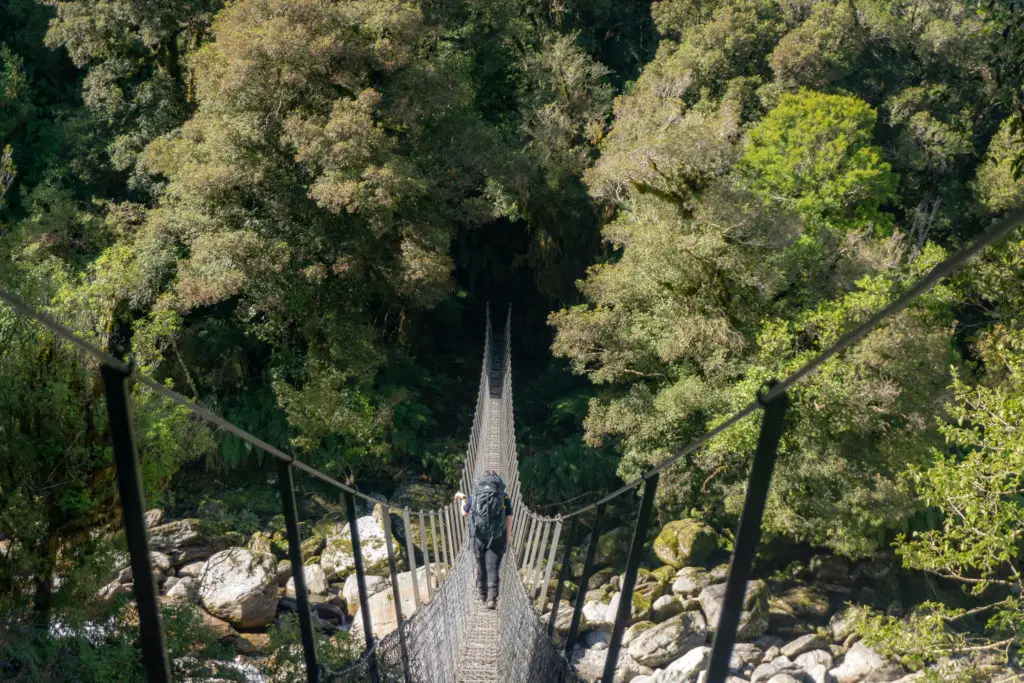
Up until Architect Hut, the Copland Track doesn’t really gain much elevation, other than some small ups and downs. This changes once you’re over Architect Creek. Between here and Welcome Flat Hut there’s about 300m to gain. Nothing too extreme, but the climb is steady with some steeper sections at times. This includes two landslides that are a bit of a scramble to get over, and where you wouldn’t want to lose your footing (but Matt, who doesn’t like heights, didn’t find them that bad – the swing bridges were worse). To the right / south we caught glimpses of the impressive Punchbowl waterfall on Therma Creek across the valley.

There were a few more bridges (mostly one-person capacity solid bridges), that I counted down to let everyone know how far away from Welcome Flat Hut we were. Unfortunately for us, there had been an extra bridge added that wasn’t marked on the topomap I’d loaded on my phone. (The clue really should have been that after the “last” bridge we didn’t start to head downhill. I’m going to blame that rookie mistake on fatigue). So it was with mixed feelings; mainly disappointment and awe, that I came across another bridge after what was meant to be the “last” bridge. This one crossing Shiels Creek. (That was also another clue – most of the bridges have named signs). Disappointment, because it meant we still had another 20 or so minutes to go until the hut. And awe, because holy mother of heights that was an impressive swing bridge.
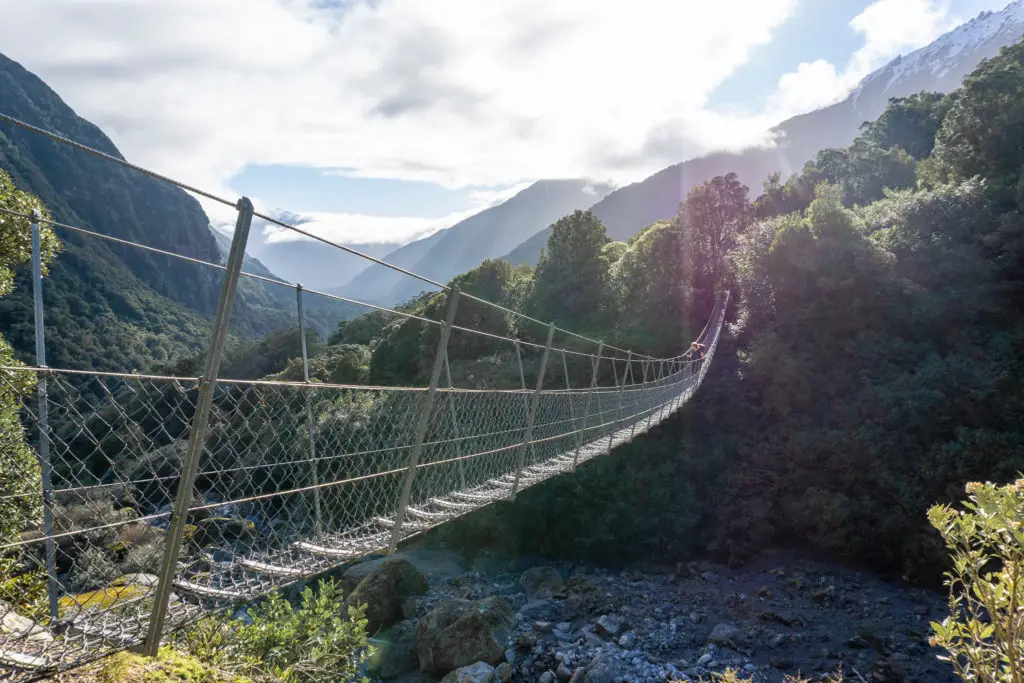
After we’d all taken turns crossing Shiels Creek, marvelling at the views and height (or studiously not looking down, in Matt’s case), the track did indeed start heading gently downwards through more mossy forest. And then we turned the corner and Welcome Flat Hut was right there!

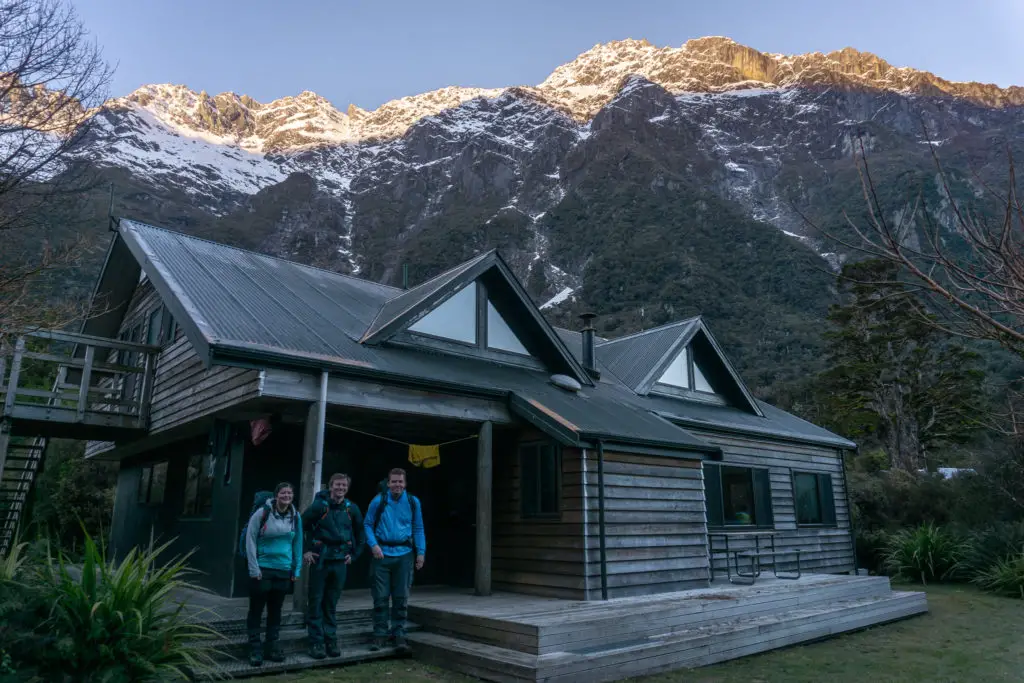
Welcome Flat Hut is lovely and expansive. The lower floor is made up of a generous kitchen area with plenty of bench space and a common room with lots of tables and a fire. (Plus the Sierra Room; the old wardens’ quarters that has been transformed into upmarket (for tramping) private accomodation with lighting, a shower, gas and cooking utensils). Upstairs are four separate bunk rooms. (With no actual bunks, all of the beds are on a small platform to one side of the room). All in all it’s an awesome hut, I was sorry we didn’t get to spend more time in it.
If I’m honest, I didn’t even walk into the hut first, not even to claim a bed. We dumped our gear on the deck and walked the 50m or so to the hot pools to check them out. After all, this was the whole reason we’d just carted ourselves and our gear 18km up the river! They’re what the Copland Track is all about. I’d been starting to worry that they wouldn’t live up to expectations. And that I’d dragged everyone along for no good reason.
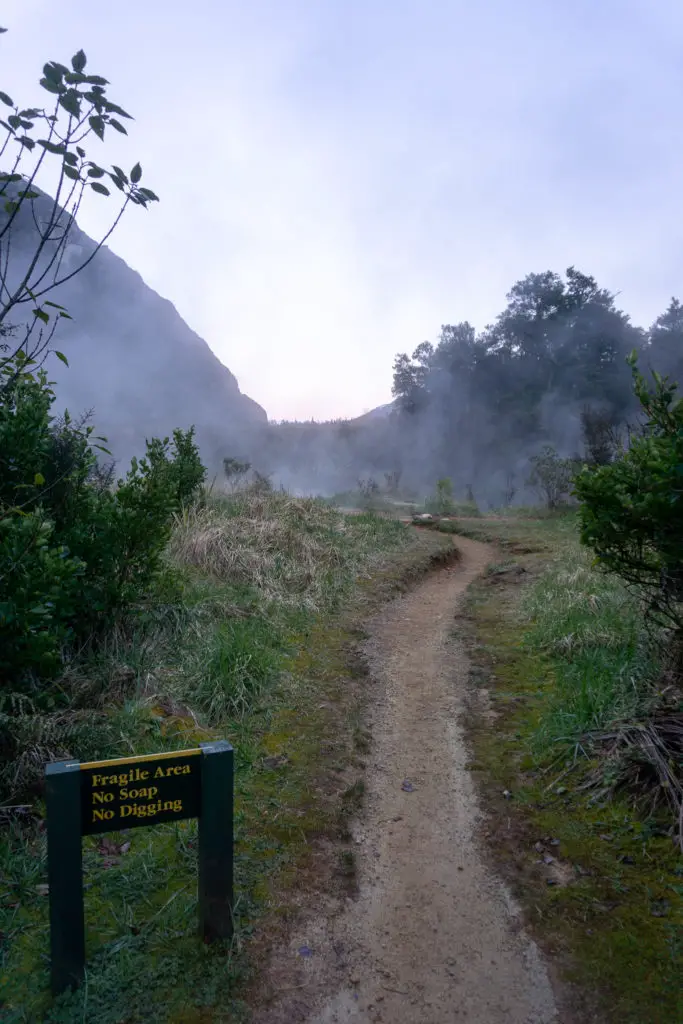
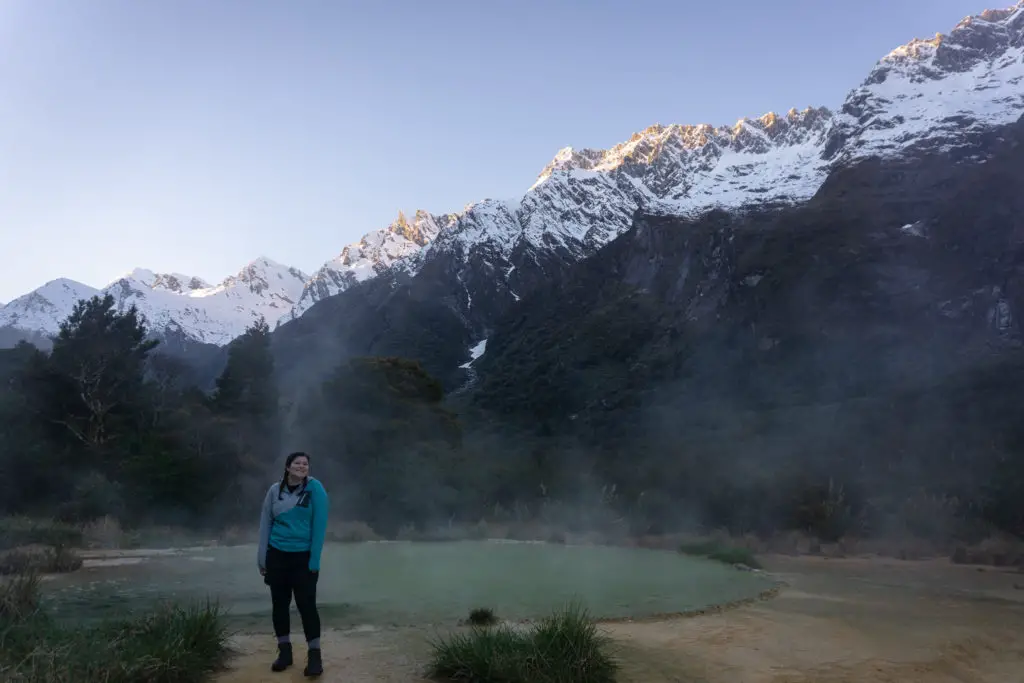
Happily the pools looked very inviting. (Despite the sign warning that if you put your head under the water you would almost definitely die of amoebic meningitis). There was already a group of people, who’d spent the previous night at the hut, soaking their muscles in them. We wandered around, interested in the pools. There were three decent sized pools sitting on a terraced mud flat. The deepest and hottest would have been just above knee height, the rest were below the knee. All of varying temperatures depending on how close they were to the bubbling source of the water.
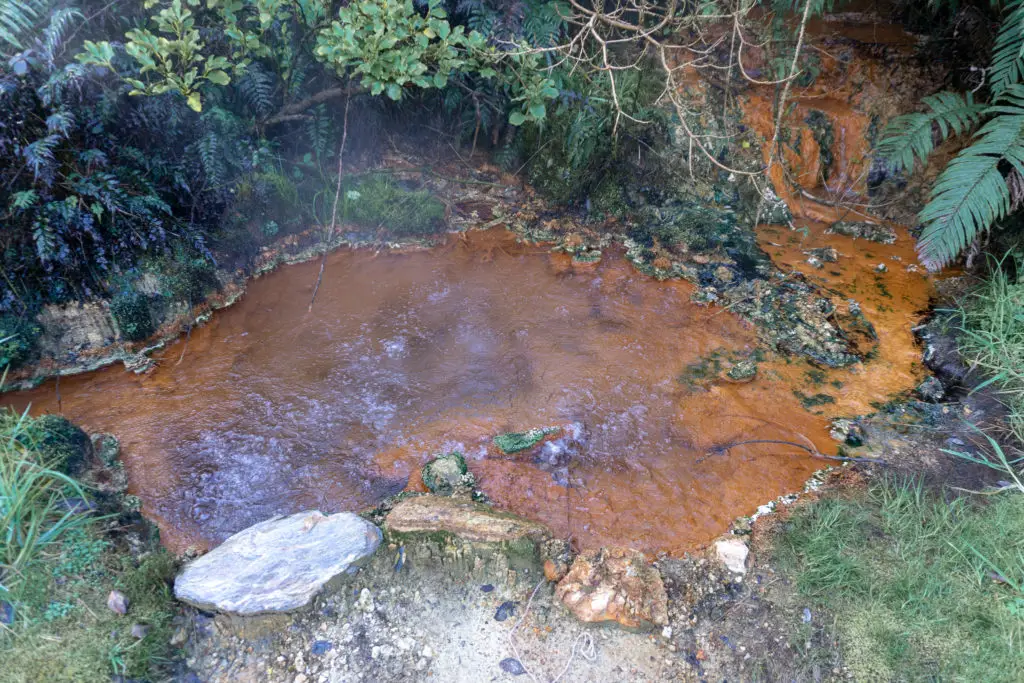
The water bubbles up out of the ground at around 56°C before running down orange-tinged channels to the pools. These are carefully monitored and maintained by the wardens. They shift rocks and divert water to make sure the pools aren’t too hot for tired trampers. The Alpine Fault (between the Pacific and Indo-Australian tectonic plates) runs down the Alps only 12km to the west of the pools. It’s the super hot uplifted rocks from the fault-line that heat the water as it rises to the surface (so nothing too sulphuric here!). Previous earthquakes have actually changed the temperature of the pools as the makeup of earth below the fault shifts.
Becky, Michael, Matt and I were keen to hop in and see what they were like for ourselves. We raced back to Welcome Flat Hut, claimed one of the upstairs bunk rooms for our group, got changed and headed back down.
We waded into the pools, cautiously trying not to slip on the slightly muddy bottom, as we made our way over to an edge to sit and relax. The water was deliciously warm, especially as we walked past the channel with fresh (very) hot water running into the pool. Near the edge of the pool we found shallow depressions, made from years of people sitting and relaxing in the same spot. We settled in for a long, relaxing soak.
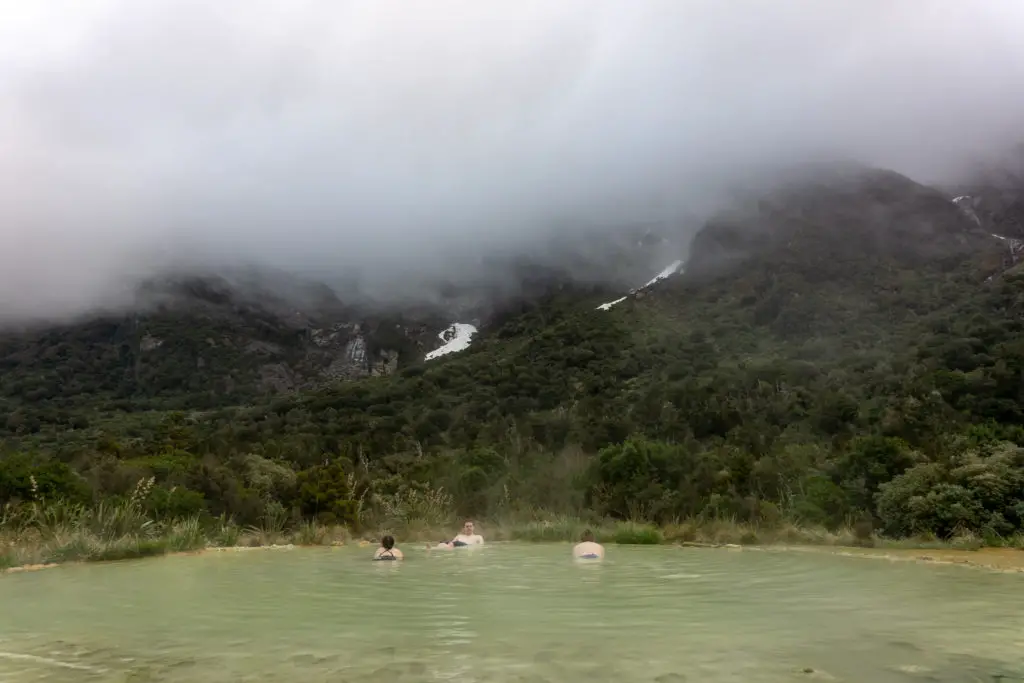
Although we’d had a blue-bird day walking in, the clouds started to form along the mountains on either side of the valley. They soon lowered, hiding our view of the peaks, although we could still see snow from avalanche debris accumulated in the gulleys. We sat relaxing, soaking in the view and the water, chatting with the other group from Christchurch who were spending two nights at the hut. I was immediately jealous of their superior planning. We’d be leaving really early the next morning in order to complete the 7 hour walk out and then drive the 6.5 hours home.
Another lesson that the Christchurch group reinforced for me: alcohol, dehydration, and hot pools are not good friends. The guys had spent most of the afternoon soaking and drinking away their worries. They were bright red and queasy-looking when they stood up. Plus hangovers and day-long hikes with a pack are also a highly effective form of torture. To be honest though, I was impressed with the number of stubbies, cans of cider, and bottles of whisky and vodka they’d managed to fit in their packs and cart in. The only logical explanation was that they had access to a magic Marry Poppins / Hermione Granger bag.
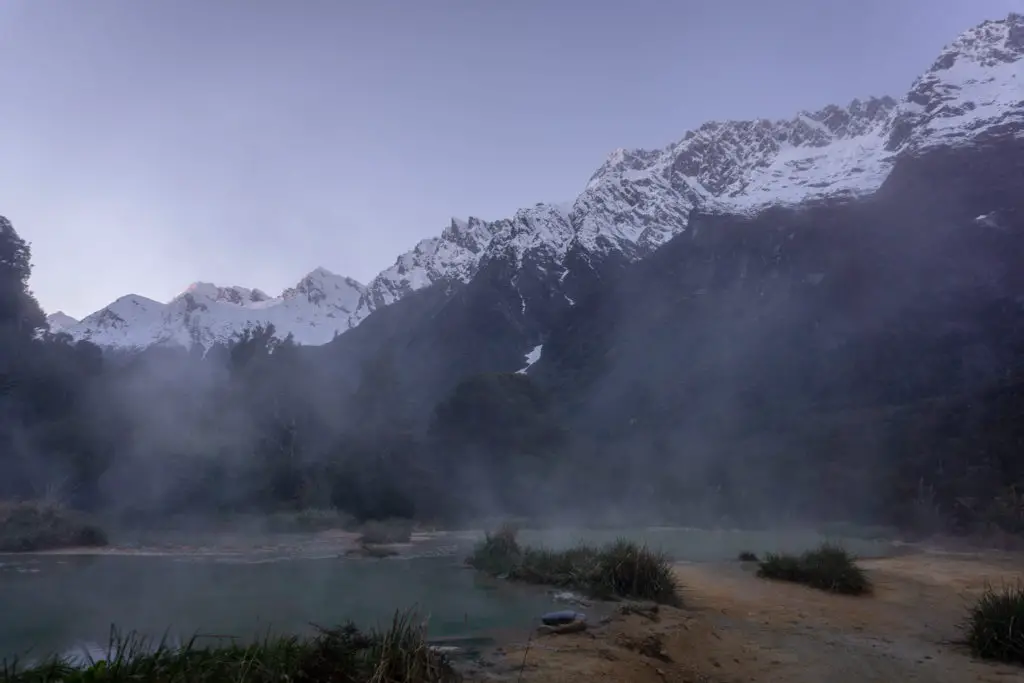
We swapped between the middle (medium temperature) pool and the lower (cooler) pool when we got too hot / cold. We didn’t feel the need to take a dip into the hottest pool on this trip. There weren’t even any sandflies to bother us. (Winter is definitely the season to visit the pools). I’ve read recommendations that trampers buy head nets to keep the swarms at bay. The wardens came by a few times to check on everyone, and make sure they didn’t need to adjust the temperatures for us (by moving rocks in the channels to change the flow of water). They also checked on the egg they had “cooking” in the small pool where the water was bubbling up from the ground. After two hours it had only just started to cook, although they said they’d try for a longer time the next day.
Too soon it was time to hop out, our fingers and toes completely pruned, and cook up some de-hy dinner. The Christchurch group let us know that one of the small streams we’d crossed right before arriving to the hut was actually lukewarm, fed in part by the run-off from the pools, and the perfect place to rinse off. We found it easily. The water was clean and up to hip-height right by the bridge. We all took turns jumping in and rinsing off the green-tinged silty mud from the pools that had infiltrated our togs.

As it was clouded in, we didn’t go back to the hot pools after dinner. (Although sitting in them looking up at the stars would have been amazing). Instead we spent the time teaching Michael and Becky to play 500. Michael also didn’t know how to plays K&As (also known as Scum / President depending on the country), which we quickly rectified. I shared out some of my Baileys, and we made up some delicious hot chocolates for dessert. The hut was busy, but we had our room to ourselves and a good night’s sleep with no obstructive sleep apnoea or angry German sleep talkers (both not experiences I ever want to repeat).
Day Two: And back again …
We had an early start the next morning. Up before sunrise, cooking porridge for breakfast and then out to the pools to watch the first light on the tops of the (now cloud-free) peaks in the pre-dawn silence. We must have spent close to an hour watching the every-changing light on the snow-capped mountains, and the whirling steam coming off the pools. I imagined my parents sitting in the pools 30 years ago with their friends. And all of the other trampers who’ve been drawn by the lure of the hot pools through the centuries.

The Copland Track has a long history; Ohinetamatea of Te Runanga o Makawhio and her whānau initially explored the Copland Valley because of a well-fed tui leading them astray, and her descendants trekked in to the hot pools.
In 1892, after Europeans had arrived to Aotearoa, Charlie Douglas, and later Arthur Harper, were commissioned to survey the Copland Valley. The aim was to establish a possible transalpine road access between the Hermitage at Mt Cook Village and the west coast for “tourism purposes”. A bridle trail was completed in the early 1900s. Tourists were able to ride horses up to the old Welcome Flat Hut (since destroyed by a landslide – the new hut is in a different location), then hike on over the pass to the luxury of the Hermitage. Thankfully the road never eventuated and the Copland remains a wild, if popular, valley. You can read more about the track’s interesting history here.
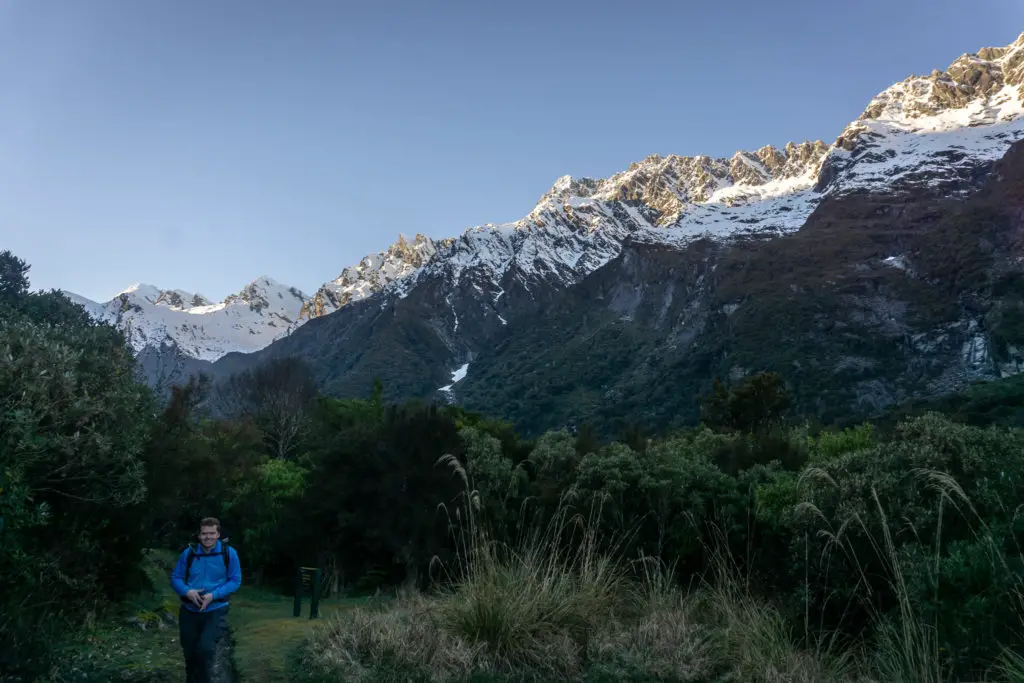
It was with regret that I turned away from the pools, shouldered my pack and set off for the long walk back out to the carpark.
Boy was it long.

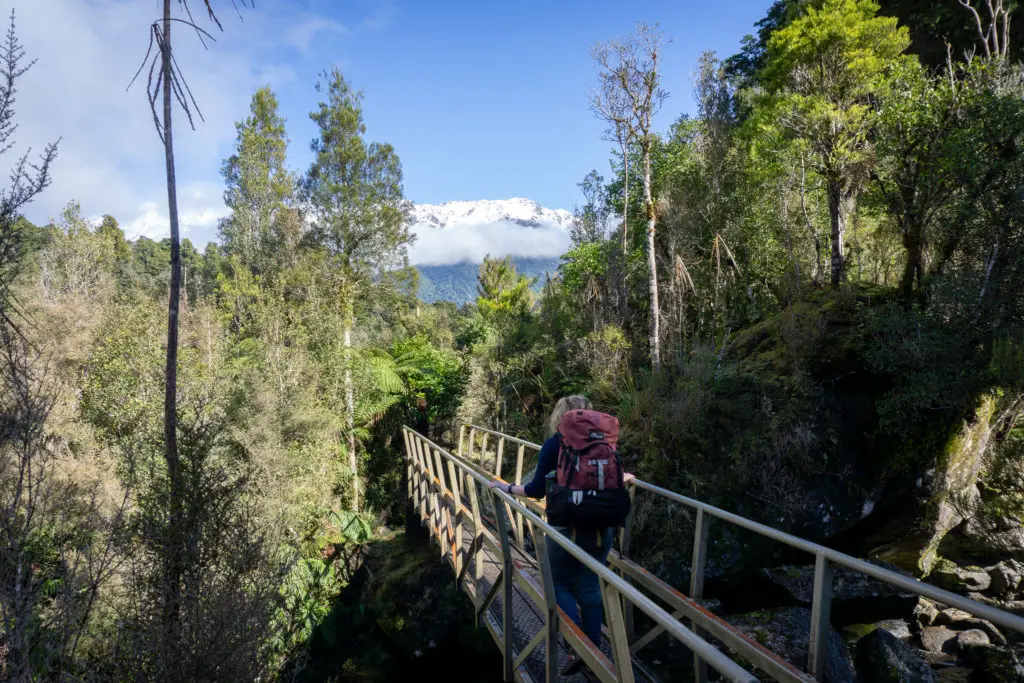

We made better time on the way out than we had on the way in. But I had a hard time remembering the times I’d set in my head the day before (this bridge means it’s x amount of time to the end, etc.). So it felt longer (as it often does). But we made it! We also passed two young girls hiking in late in the day with reusable shopping bags as packs over their shoulders, thin leggings, and sneakers. There was much shaking of heads after they passed.
The sandflies that we’d somehow avoided up until this point, made their presence known at Rough Creek. (Which we forded with boots, socks and gaiters on. They needed a good clean from the mud anyway). They were also out in force at the carpark, as we were changing into our clean clothes for the long, long drive home. (Thanks Mum for having a delicious roast dinner and apple crumble ready for a starving crew as we stopped on our way down!)

All in all it was a trip that lived up to expectations. A long river / valley walk in to lovely hot pools. The track itself wasn’t too exciting. It might be a disappointment if you were expecting amazing vistas, although it does have its own less impressive pretty spots. But the hot pools were definitely worth it for me. Maybe if they’d been lots of sandflies I may have changed my tune.
Now I just have to find another fine weather weekend next winter so I can spend two nights / a whole day at the pools (and explore further up-valley to Douglas Rock Hut). Wish me luck!
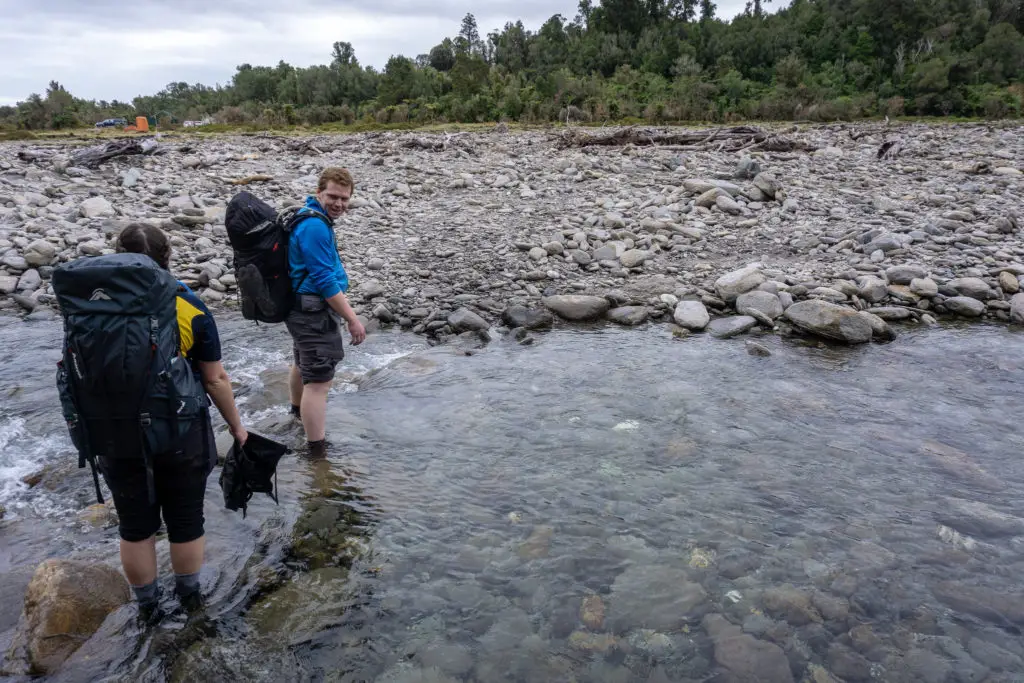
Safety
As always, please stay safe when you’re out exploring. Follow the Outdoor Safety Code:
- Choose the right trip for you (read my article on tramping safety, talk to DOC)
- Understand the weather
- Pack warm clothes and extra food (check out my post here about what gear you need to take)
- Share your plans and take ways to get help (have an emergency beacon on your person)
- Take care of yourself and each other
If you’re not feeling super confident then you can always get in touch with me here on the blog or on my Instagram. Or take a look at my Tramping 101 series which includes this post about how to stay safe in the outdoors.
Also don’t be a dick, check out my guide to New Zealand tramping etiquette.
Stay safe and get outside!
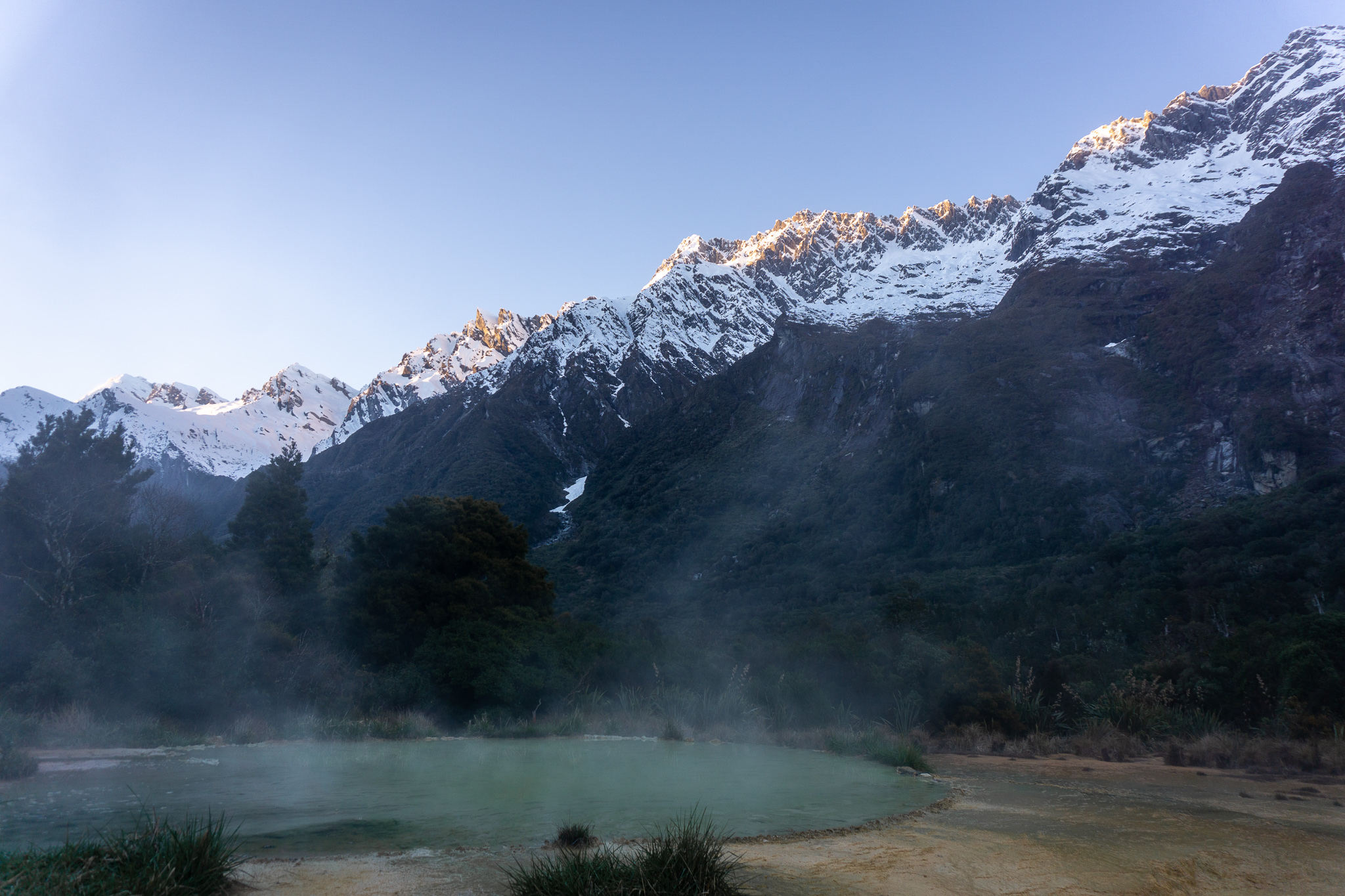
Thanks for the detail
No worries! Thanks for your comment Stephanie 🙂